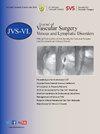斜坡筑堤技术中的线圈加胶水与线圈加硬化剂在反流型盆腔静脉疾病栓塞疗法中的有效性和安全性对比。
IF 2.8
2区 医学
Q2 PERIPHERAL VASCULAR DISEASE
Journal of vascular surgery. Venous and lymphatic disorders
Pub Date : 2024-07-06
DOI:10.1016/j.jvsv.2024.101945
引用次数: 0
摘要
研究目的本研究旨在评估斜坡堤坝技术中线圈加胶水与线圈加硬化剂治疗反流型盆腔静脉疾病的有效性和安全性:分析对象包括2019年至2021年期间确诊为反流型盆腔静脉疾病并接受线圈加胶水(CPG)或线圈加硬化剂(CPS)治疗的患者。纳入标准为持续6个月以上的非周期性疼痛、非典型静脉曲张、经阴道多普勒超声(TVDUS)和计算机断层扫描静脉造影(CTV)确诊,并排除压迫因素和其他疾病。根据以下协变量按1:1.1的比例进行倾向得分匹配:年龄、妊娠、体重指数、治疗前VAS、痛经、排尿困难、尿急、胀痛、腰痛、外阴静脉曲张、阴道静脉曲张和下肢静脉曲张。通过使用不同的栓塞材料栓塞目标病灶,可缓解疼痛。在 1、3、6、12、24 和 36 个月时,通过视觉模拟量表(VAS)和 TVDUS 检查比较不同栓塞材料的疗效和安全性:在 495 名患者中,通过倾向性评分匹配,88 名患者被选入 CPG 组,77 名患者被选入 CPS 组。这些患者接受了 36 个月的随访。线圈加胶水(CPG)组术前 VAS 评分为 8 分(6-8 分),线圈加硬化剂(CPS)组术前 VAS 评分为 8 分(7-8 分),P=0.64。CPG 组栓塞后 VAS 评分为 2.05±0.37,CPS 评分为 2.14±0.35(P=0.55)。共有 28 例(16.9%)出现并发症,其中大部分为栓塞后一过性疼痛。没有发生线圈栓塞肺部等严重并发症。此外,通过使用斜坡筑堤技术(SET),CPG 组比 CPS 组使用的线圈更少。CPG 组的线圈平均长度为(77.18±33.82)厘米,CPS 组为(105.29±71)厘米(P=0.001)。CPG 组平均手术时间为(44.49±5.72)分钟,CPS 组平均手术时间为(43.45±4.18)分钟(P=0.19)。CPG组的放射剂量为(398.40±76.16)mGy,CPS组的放射剂量为(388±44.23)mGy(P=0.30)。CPG组的中位无复发生存期(RFS)为34.23个月(95% CI 33.2-35.2),CPS组的中位RFS为30.39个月(95% CI 28.2-32.6),LogRank=0.018:栓塞治疗反流性PeVD安全有效,熟练使用带线圈加胶水的SET可提高疗效并减少并发症。本文章由计算机程序翻译,如有差异,请以英文原文为准。
Effectiveness and safety of coils plus glue in slope embankment technology versus coils plus sclerosant in embolization therapy for reflux-type pelvic venous disorders
Objective
This study aimed to evaluate the effectiveness and safety of coils plus glue (CPG) in slope embankment technology vs coils plus sclerosant (CPS) in treating reflux-type pelvic venous disorders.
Methods
The analysis included patients diagnosed with reflux-type pelvic venous disorders who were treated with CPG or CPS from 2019 to 2021. The inclusion criteria were noncyclic pain lasting more than 6 months, atypical varicose, and transvaginal Doppler ultrasound (TVDUS) and computed tomographic venography confirming the diagnosis and excluding compression factors and other diseases. Propensity score matching was performed at a 1:1.1 ratio based on the following covariates: age, pregnancy, body mass index, pretreatment visual analog scale (VAS), dysmenorrhea, dyspareunia, urinary urgency, tenesmus, low back pain, vulvar varicosities, vaginal varicosities, and lower limb varices. The pain was relieved by embolizing the target lesions with different embolic materials. The efficacy and safety of the different embolization materials were compared by VAS and TVDUS examinations at 1, 3, 6, 12, 24, and 36 months.
Results
From a total of 495 patients, 88 patients were selected from the CPG group and 77 patients from the CPS group by propensity score matching. The patients were followed up for 36 months. The preoperative VAS score of the CPG group was 8 (range, 6-8), and the CPS score was 8 (range, 7-8; P = .64). The postembolization VAS score of the CPG group was 2.05 ± 0.37, and the CPS score was 2.14 ± 0.35 (P = .55). A total of 28 cases (16.9%) showed complications, most of which were transient pain after embolization. No serious complications such as coil embolization to the lungs occurred. In addition, the CPG group used fewer coils than the CPS group by using the slope embankment technique. The mean coil length of the CPG group was 77.18 ± 33.82 cm, and the CPS group was 105.29 ± 71 cm (P = .001). The CPG group had an average operative time of 44.49 ± 5.72 minutes, whereas the CPS group took 43.45 ± 4.18 minutes on average (P = .19). The radiation dose in the CPG group was 398.40 ± 76.16 mGy, and the radiation dose in the CPS group was 388 ± 44.23 mGy (P = .30). The median recurrence-free survival in the CPG group was 34.23 months (95% confidence interval, 33.2-35.2), and the median recurrence-free survival in the CPS group was 30.39 months (95% confidence interval, 28.2-32.6; log rank P = .018).
Conclusions
Embolization therapy for refluxing PeVD was safe and effective, and proficient use of slope embankment technique with CPG increased efficacy and reduced complications.
求助全文
通过发布文献求助,成功后即可免费获取论文全文。
去求助
来源期刊

Journal of vascular surgery. Venous and lymphatic disorders
SURGERYPERIPHERAL VASCULAR DISEASE&n-PERIPHERAL VASCULAR DISEASE
CiteScore
6.30
自引率
18.80%
发文量
328
审稿时长
71 days
期刊介绍:
Journal of Vascular Surgery: Venous and Lymphatic Disorders is one of a series of specialist journals launched by the Journal of Vascular Surgery. It aims to be the premier international Journal of medical, endovascular and surgical management of venous and lymphatic disorders. It publishes high quality clinical, research, case reports, techniques, and practice manuscripts related to all aspects of venous and lymphatic disorders, including malformations and wound care, with an emphasis on the practicing clinician. The journal seeks to provide novel and timely information to vascular surgeons, interventionalists, phlebologists, wound care specialists, and allied health professionals who treat patients presenting with vascular and lymphatic disorders. As the official publication of The Society for Vascular Surgery and the American Venous Forum, the Journal will publish, after peer review, selected papers presented at the annual meeting of these organizations and affiliated vascular societies, as well as original articles from members and non-members.
 求助内容:
求助内容: 应助结果提醒方式:
应助结果提醒方式:


